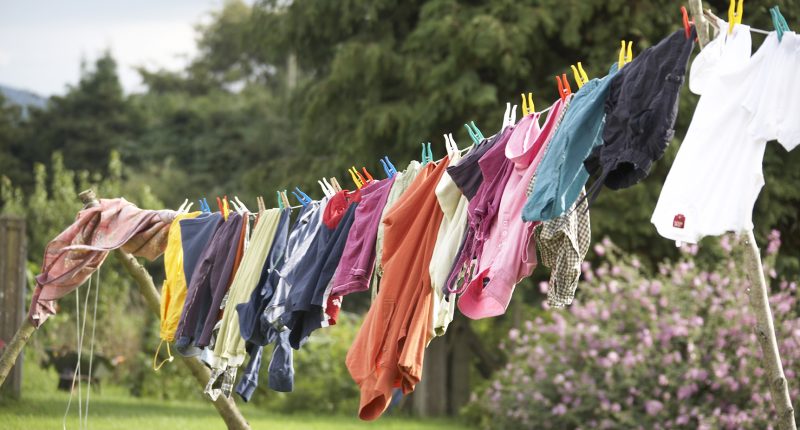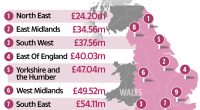GETTING clothes washed and dried is a never ending chore that can eat up a big chunk of family budgets.
Tumble dryers feel like an easy way to make the job more efficient but are one of the most energy-hungry home appliances to run.
The average cycle to dry clothes can cost between 59p an hour for a heat pump appliance and up to £1.44 for a vented dryer, according to data from appliance firm Hoover.
More than half of households use a tumble dryer, running for more than fours a week on average costing around £65 a year.
In total, people across the UK are spending £1bn a year on energy to dry their clothes, according to data estimates by household goods firm Brabantia.
However, Netweather broadcaster Jo Farrow has shunned the appliance.
Read more on energy bills
The meteorologist and mum says using a tumble dryer is a waste of money and laundry can be dried outdoors in the UK every month of the year.
She says outside temperatures do not need to be warm to dry clothes outdoors.
In fact, the weather expert said the most important factor is wind speed and not air temperature when drying washing.
Jo says: “I think as a nation we’ve slipped into being over reliant on tumble dryers and it’s not kind to our pockets.
Most read in Money
“During the winter months, it’s very easy to get out of the habit of hanging your washing out on the line.”
She explains that many people believe it’s too wet or too windy for a large part of the year in the UK to hang clothes outside – but actually even when temperatures are as low as five degrees you can dry laundry.
A fifth of people are put off from drying outdoors if the temperature falls below 15 degrees, according to Brabantia research.
A similar number feel that clouds were a reason to avoid using the washing line.
Jo adds: “There is plenty of opportunity for us to dry our laundry outdoors all year round.
“In fact, because the country can be windy, we often have the ideal conditions to ditch the tumble dryer and get our laundry outside.”
“People in snow covered countries like Iceland still bother to put their laundry out in winter with low temperatures, if it’s windy.”
Here she shares her tips for drying clothes outdoors…
WIND SPEED
Once the wind reaches 15mph, clothes will start to dry naturally outside, as long as it’s not foggy or raining, according to Jo.
So as long as you can feel a gentle breeze, it’s worth hanging out laundry even if temperatures are chilly.
Jo says that clothes should start to dry as long as the mercury is above five degrees.
WATCH THE FORECAST
The most favourable weather conditions for drying laundry are warm temperatures with no rain, no dampness and a gentle breeze.
However, even on a day that starts off wet or when showers are forecast, there are usually still brief opportunities to dry laundry outside as our UK weather is so changeable.
The frustration of nearly bone-dry washing getting soaked by a downpour is real so Jo says it’s crucial to understand the weather forecast on these days.
She adds: “Low cloud can give drizzle or patchy rain and on a grey day when this kind of weather sets in.
“Fog is essentially a cloud on the ground, but it will soon clear if the breeze picks up or the sun is strong enough.
“It can be worth hanging out laundry in early fog or grey low cloud, but it is a gamble. Study the weather forecast on these days.”
ADAPT YOUR LOADS
If rain is on the way, opt for quick-drying fabrics to dry outside.
Synthetic fabrics such as polyester or nylon will dry quickly because these fabrics give up moisture and dry faster than natural fibres.
Cotton can take longer to dry so save washing denim or towels on for days when the forecast is less changeable.
MORE WAYS TO SAVE
Cutting down on using the tumble dryer is not the only way to cut back on your laundry bills.
If you do expect to use a tumble, try an extra spin cycle in washing machine first which can shorten the time you have the dryer on.
Reducing the number of loads you can cut your usage and bill so make sure your’e not half filling the machine before putting on a cycle.
Unless clothes are heavily soiled you can likely opt for shorter or eco cycles. which run for less time or at a lower temperature.
READ MORE SUN STORIES
And if you’re shopping for a new washing machine, look for an efficient washing machine could save up cash in the long run.
It might cost more upfront but you will spend less over the lifetime of the product.
How do I calculate my energy bill?
BELOW we reveal how you can calculate your own energy bill.
To calculate how much you pay for your energy bill, you must find out your unit rate for gas and electricity and the standing charge for each fuel type.
The unit rate will usually be shown on your bill in p/kWh.The standing charge is a daily charge that is paid 365 days of the year – irrespective of whether or not you use any gas or electricity.
You will then need to note down your own annual energy usage from a previous bill.
Once you have these details, you can work out your gas and electricity costs separately.
Multiply your usage in kWh by the unit rate cost in p/kWh for the corresponding fuel type – this will give you your usage costs.
You’ll then need to multiply each standing charge by 365 and add this figure to the totals for your usage – this will then give you your annual costs.
Divide this figure by 12, and you’ll be able to determine how much you should expect to pay each month from April 1.










